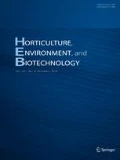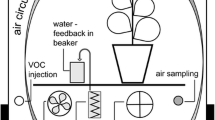Abstract
This study aims to suggest an improved experimental method to reveal the ability of indoor plants to reduce CO2 concentrations, as well as to display the individual CO2 reduction characteristics of various indoor plants in accordance with this improved method. In previous studies, experiments were conducted under the condition in which the CO2 concentration in the experimental chamber is set only once to a high initial level of 1,000 ppm. However, in real conditions, CO2 concentration gradually increases in a room after the occupants enter. Hence, the existing experimental method can be improved in view of “light saturation and CO2 compensation”. Accordingly, in this study, the CO2 reduction characteristics of indoor plants under 2 conditions used in the existing method of measurement (Case 1) and the condition in the new method, which considers that CO2 concentration gradually increases through the respiration of experimental animals (Case 2)-were measured and compared against each other. For all plant samples, the level of CO2 reduction was higher in Case 2 than in Case 1, and the rate of CO2 reduction increases with time. The inflection point of CO2 concentration appeared at leaf areas of 9,000 cm2 in peace lily and areca palm, and 6,000 cm2 in weeping fig.
Similar content being viewed by others
Literature Cited
ASHRAE. 2004. Thermal environmental conditions for human occupancy. ASHRAE Standard 55-2004. American Society of Heating, Refrigerating and Air-Conditioning Engineers, Incorporated, Atlanta, GA, USA.
Azcón-Bieto, J., G.D. Farquhar, and A. Caballero. 1981. Effects of temperature, oxygen concentration, leaf age and seasonal variations on the CO2 compensation point of Lolium perenne L. Comparison with a mathematical model including non-photorespiratory CO2 production in the light. Planta 152:497–504.
Chang, J.C. and T.S. Lin. 2007. Gas exchange in litchi under controlled and filed conditions. Scientia Horticulturae 114:268–274.
Cornejo, J.J., F.G. Munoz, C.Y. Ma, and A.J. Stewart. 1999. Studies on the decontamination of air by plants. Ecotoxicology. 8:311–320.
Darlington, A.B., J.F. Dat, and M.A. Dixon. 2001. The biofiltration of indoor air: Air flux and temperature influences the removal of toluene, ethylbenzene, and xylene. Environ. Sci. Technol. 35: 240–246.
Farquhar, G.D., S. von Caemmerer, and J.A. Berry. 1980. A biochemical model of photosynthetic CO2 fixation in C3 species. Planta 149:178–190.
Fujii, S., H. Cha, N. Kagi, H. Miyamura, and Y.S. Kim. 2005. Effects on air pollutant removal by plant absorption and adsorption. Building Environ. 40:105–112.
Giese, M., U.B. Doranth, C. Langebartels, and H. Sandermann. 1994. Detoxification of formaldehyde by the spider plant (Chlorophytum comosum L.) and by soybean (Glycine max L.) cell-suspension cultures. Plant Physiol. 104:1301–1309.
Godish, T. and C. Guindon. 1989. An assessment of the botanical air purification as a formaldehyde mitigation measure under dynamic laboratory chamber conditions. Environ. Pollut. 62:13–20.
Gupta, S., M. Khare, and R. Goyal. 2007. Sick building syndrome-a case study in a multistory centrally air-conditioned building in the Delhi City. Building Environ. 42:2797–2809.
Hall, A.E. and E.D. Schulze. 1980. Stomatal response to environment and a possible interrelation between stomatal effects on transpiration and CO2 assimilation. Plant Cell Environ. 3:467–474.
Han, S.-W. and K.-J. Bang. 1996. The study on the purification effect of CO2 in interior plants. J. Korean Flower Res. Soc. 5:33–42.
Henrik, S. 1986. Stomatal-dependent and stomatal-independent uptake of NOx. New Phytol. 103:199–205.
Hong, S.-C., H.-M. Jou, T.J. Cho, C.-W. Lee, Y.-T. Jung, and B.-S. Son. 2008. A study of indoor air quality of public facilities in Chung-Nam area. J. Environ. Sanit. Eng. 23:35–45.
Jarvis, P.G. and J.I.L. Morison. 1981. The control of transpiration and photosynthesis by the stomata, p. 247–279. In: P.G. Jarvis and T.A. Mansfield (eds.), Stomatal physiology. Cambridge University Press, Cambridge, MA.
Jenkins, P.L., T.J. Phillips, J.M. Mulberg, and S.P. Hui. 1992. Activity patterns of Californians: Use of and proximity to indoor pollutant sources. Atmos. Environ. 26:2141–2148.
Jeong, G.-H. and T.-Y. Chon. 2006. Study of indoor air quality from the several offices in Busan area. J. Korean Soc. Environ. Anal. 9:7–12.
Jeong, J.Y., B.K. Lee, and Y.G. Phee. 2007. Assessment of indoor air quality in commercial office buildings. J. Korean Soc. Occup. Environ. Hyg. 17:31–42.
KFDA. 2005. Good laboratory practice regulation for nonclinical laboratory studies. Korea Food and Drug Administration (Notification No. 2005-79).
Kil, M.J., K.J. Kim, J.K. Cho, and C.H. Park. 2008. Formaldehyde gas removal effects and physiological responses of Fatsia japonica and Epipremnum aureum according to various light intensity. Kor. J. Hort. Sci. Technol. 26:189–196.
Kim, Y.-S., Y.-H. Yoon, M.-O. Kang, and H.-J. Kang. 1993. Indoor air quality in office buildings. Bull. Inst. Environ. Med. 3:99–111.
Kondo, N. and H. Saji. 1992. Tolerance of plants to air pollutants. J. Jpn. Soc. Air Pollut. 27:273–288.
Lee, J.-H. 2004. Human activity level and improvement effect on indoor air quality of ornamental flowering plants to remove carbon dioxide. J. Korean Soc. People Plants Environ. 7:118–129.
Lee, K.-H., Y.-G. Lee, J.-O. Yoon, E.-M. Moon, and J.-G. Jeong. 1995. A field study on indoor air quality and sick building syndrome in office building. J. Archit. Inst. Korea. 11:179–188.
Lohr, V.I. and C.H. Pearson-Mins. 1996. Particulate matter accumulation on horizontal surfaces in interiors: Influence of foliage plants. Atmos. Environ. 30:2565–2568.
Mølhave, L. and M. Krzyzanowski. 2003. The right to healthy indoor air: Status by 2002. Indoor Air. 13:50–53.
Mui, K.W., L.T. Wong, and W.L. Ho. 2006. Evaluation on sampling point densities for assessing indoor air quality. Build. Environ. 41:1515–1521.
National Institute of Horticultural & Herbal Science (NIHHS). 2011. Cultivation techniques of crops for farmers. http://www.nihhs.go.kr/.
Orwell, R., R. Wood, J. Tarran, F. Torpy, and M. Burchett. 2004. Removal of benzene by the indoor plant/substrate microcosm and implications for air quality. Water Soil Air Pollut. 157:193–207.
Oh, G.-S., G.-J. Jung, and Y.-B. Im. 2009. Experiment on reduction effect of CO2 concentration with indoor plants under illuminance condition in office. J. Reg. Assoc. Archit. Inst. Korea 11:233–240.
Oh, G.-S., G.-J. Jung, and Y.-B. Im. 2010. Experiment study on reduction of CO2 concentration with indoor plant through the occurrence patterns of CO2. J. Archit. Inst. Korea 26:329–336.
Park, M.-S., H.-S. Kim, and K.-H. Lee. 2000. A study on CO2 concentration control to improve IAQ (Indoor Air Quality) in office building. J. Korea Facility Manag. Assoc. 2:81–88.
Park, S.H., Y.Y. Lee, Y.B. Lee, and G.Y. Bae. 1998. Analysis of factors related to absorption ability of foliage plants exposed to O3. Korea Air Pollut. Res. Assoc. 14:537–543.
Ridge, I. 2008. Plants. 3rd ed. Open University Worldwide, Buckinghamshire, UK.
Sekhar, S.C. and C.S. Ching. 2002. Indoor air quality and thermal comfort studies of an under-floor air-conditioning system in the tropics. Energy Buildings 34:431–444.
Sekhar, S.C., K.W. Tham, and K.W. Cheong. 2003. Indoor air quality and energy performance of air-conditioned office buildings in Singapore. Indoor Air. 13:315–331.
Tenhunen, J.D., O.L. Lange, J. Gebel, W. Beyschlag, and J.A. Weber. 1984. Changes in photosynthetic capacity, carboxylation efficiency, and CO2 compensation point associated with midday stomatal closure and midday depression of net CO2, exchange of leaves of Quercus suber. Planta 162:193–203.
US EPA. 2011. The inside story: A guide to indoor air quality. http://www.epa.gov/iaq/pubs/insidest.html/.
Wargocki, P., L. Lagercrantz, T. Witterseh, J. Sundell, D.P. Wyon, and P.O. Fanger. 2002. Subjective perceptions, symptom intensity and performance: a comparison of two independent studies, both changing similarly the pollution load in an office. Indoor Air. 12:74–80.
Wargocki, P., D.P. Wyon, Y.K. Baik, G. Clausen, and P.O. Fanger. 1999. Perceived air quality, sick building syndrome (SBS) symptoms and productivity in an office with two different pollution loads. Indoor Air 9:165–179.
Wargocki, P., D.P. Wyon, J. Sundell, G. Clausen, and P.O. Fanger. 2000. The effects of outdoor air supply rate in an office on perceived air quality, sick building syndrome (SBS): Symptoms and productivity. Indoor Air 10:222–236.
Winner, W.E. 1994. Mechanistic analysis of plant responses to air pollution. Ecol. Appl. 4:651–661.
Wolkoff, P. 2003. Trends in Europe to reduce the indoor air pollution of VOCs. Indoor Air. 13:5–11.
Wolverton, B.C. 1996. Eco-friendly house plants: 50 indoor plants that purify the air in homes and offices. George Weidenfeld & Nicholson, Ltd., London, UK.
Wolverton, B.C., R.C. McDonald, and H.H. Mesick. 1985. Foliage plants for indoor removal of the primary combustion gases carbon monoxide and nitrogen dioxide. J. Miss. Acad. Sci. 30:1–8.
Wood, R.A., R.L. Orwell, J. Tarran, F. Torpy, and M. Burchett. 2002. Potted-plant/growth media interactions and capacities for removal of volatiles from indoor air. J. Hort. Sci. Biotechnol. 77:120–129.
World Health Organization Regional Office for Europe Copenhagen. 2000. Air quality guidelines for Europe, WHO Regional Publications, European Series, No. 91, 2nd ed.
Yoo, M.H., Y.J. Kwon, and K.C. Son. 2006. Efficacy of indoor plants for the removal of single and mixed volatile organic pollutants and physiological effects of the volatiles on the plants. J. Am. Soc. Hort. Sci. 131:452–458.
Zeiger, E. and C. Field. 1982. Photocontrol of the functional coupling between photosynthesis and stomatal conductance in the intact leaf. Plant Physiol. 70:370–375.
Author information
Authors and Affiliations
Corresponding author
Rights and permissions
About this article
Cite this article
Oh, G.S., Jung, G.J., Seo, M.H. et al. Experimental study on variations of CO2 concentration in the presence of indoor plants and respiration of experimental animals. Hortic. Environ. Biotechnol. 52, 321–329 (2011). https://doi.org/10.1007/s13580-011-0169-6
Received:
Accepted:
Published:
Issue Date:
DOI: https://doi.org/10.1007/s13580-011-0169-6




